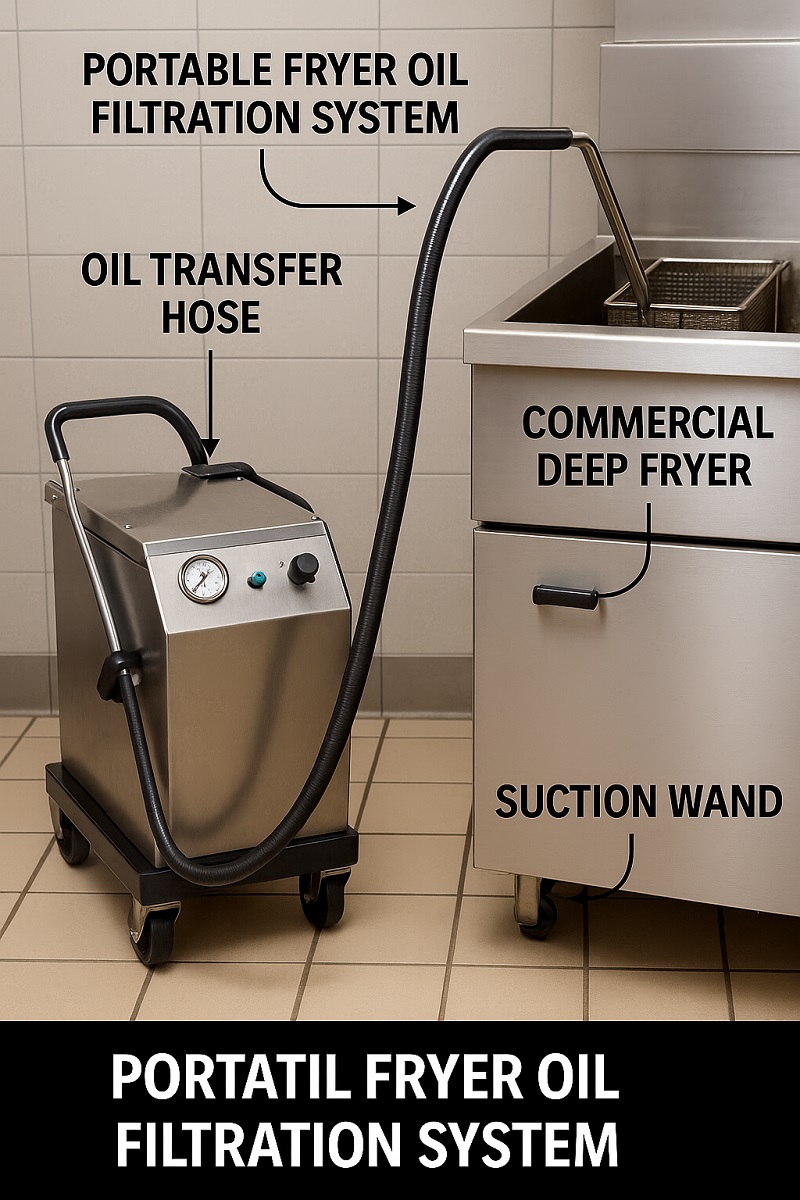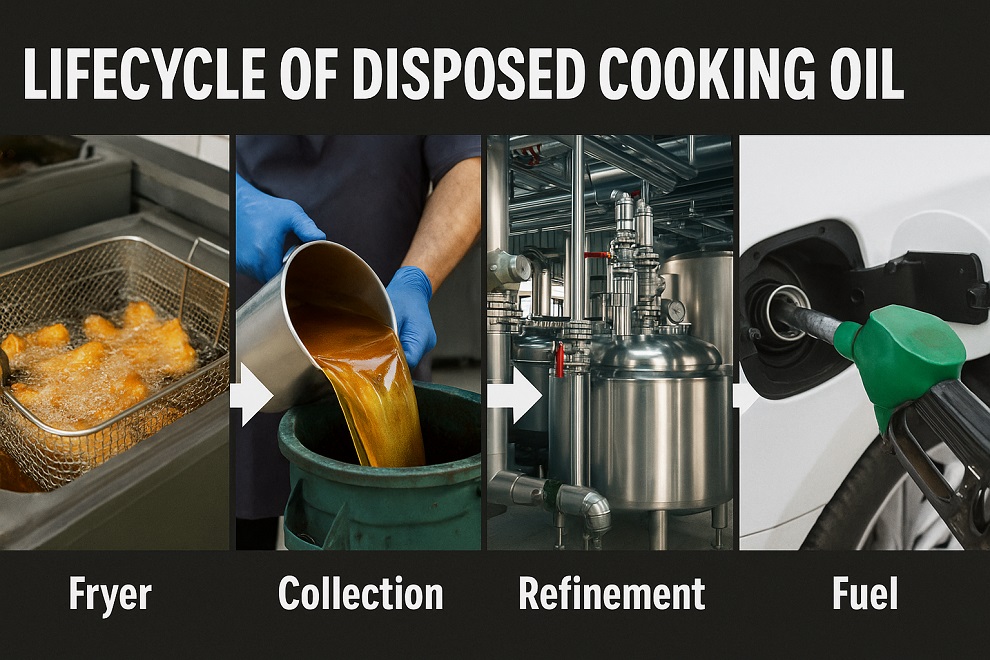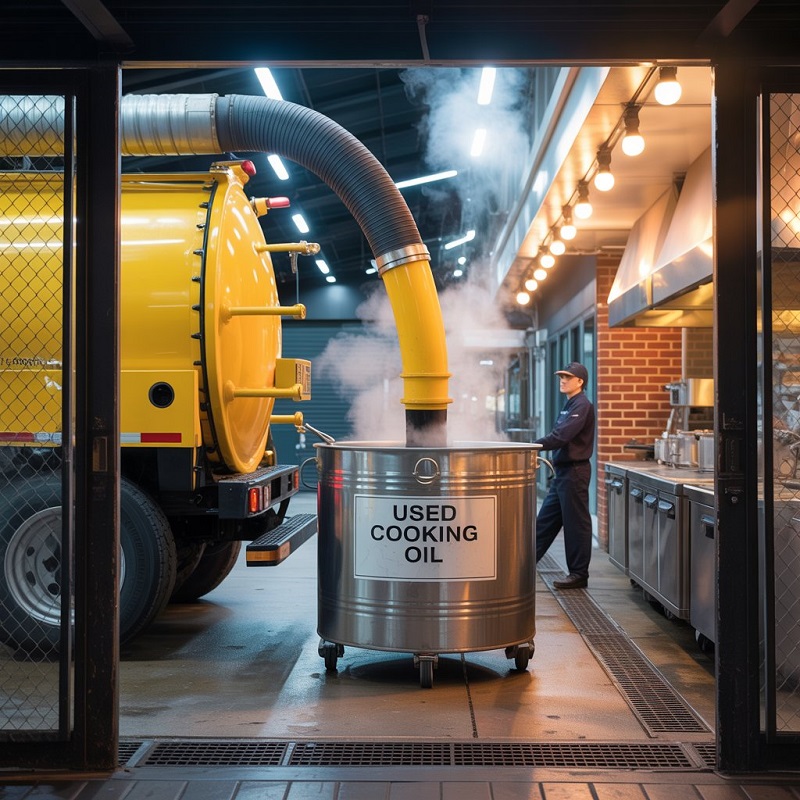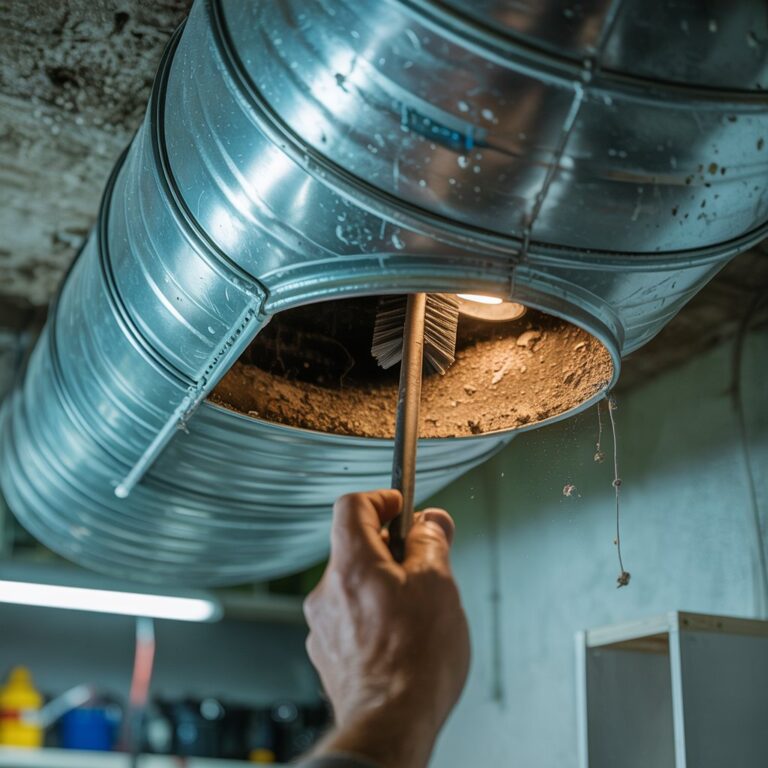Quick Answer: To dispose of cooking oil in commercial kitchens, collect it in a secure container, schedule pickup with a certified recycler, and follow EPA/state regulations to avoid fines, contamination, or fire risks.
Improper cooking oil disposal isn’t just a bad habit—it’s a costly liability. For restaurant kitchens and food production facilities, understanding how to dispose of cooking oil correctly can save you from hefty fines, protect your plumbing, and boost your environmental reputation. In this comprehensive guide, we’ll walk you through expert-backed disposal practices that ensure safety, compliance, and sustainability.
Why Cooking Oil Disposal Matters in Commercial Settings
In high-output kitchens and food factories, used cooking oil piles up fast. One deep fryer can produce several gallons of waste oil per week. But what happens when it’s dumped down the drain or tossed out with the trash?
- Environmental Damage: Cooking oil clogs municipal water systems and harms aquatic life.
- Legal Consequences: Many cities impose fines ranging from $500 to $10,000 for improper disposal.
- Fire Risk: Hot oil mishandling can trigger fires, especially in poorly ventilated areas.
- Plumbing Disasters: Grease hardens in pipes, causing costly backups.
For food professionals, responsible oil management isn’t optional—it’s essential.
What Happens If You Don’t Dispose of Oil Correctly?
Let’s look at the real-world consequences of improper oil disposal:
- Drain Clogs & Sewage Backups: Pouring oil down drains leads to blockages, overflow, and expensive plumber visits.
- Fines & Shutdowns: In cities like New York, food businesses have been shut down for illegal oil dumping.
- Pest Infestation: Improperly discarded oil attracts rodents, flies, and roaches.
- Bad Press: Public complaints and viral videos of grease overflows damage your brand.
Case in Point: A restaurant in Austin, TX was fined $15,000 and suspended for blocking a city sewer line with grease.

Approved Methods to Dispose of Used Cooking Oil
Instead of guesswork, follow these proven commercial best practices:
- Cool the Oil: Allow hot oil to cool safely to prevent burns and vapor hazards.
- Use Approved Storage Containers: Transfer oil to leak-proof, fire-resistant containers labeled for “Used Cooking Oil.”
- Partner with a Licensed Recycler: Schedule regular pickups from certified renderers or biodiesel processors.
- Never Mix with Water or Other Waste: Water and oil can cause hazardous reactions when transported.
️ Pro Tip: Food plants often install bulk containment tanks that connect to fryers via filtration pumps for safe, hands-free disposal.
How to Dispose of Cooking Oil at Different Business Scales
Not all kitchens generate the same volume of oil—and not all businesses have the same disposal needs. Understanding how to dispose of cooking oil based on your operation’s size ensures efficiency, safety, and legal compliance.
Small Restaurants & Diners
- Use oil caddies to transport waste to sealed bins.
- Partner with local grease recyclers for weekly pickup.
- Label containers clearly to avoid cross-contamination.
Medium-Sized Chains or Caterers
- Use portable filtration systems to extend oil life.
- Install stationary grease bins with locking lids outside.
- Schedule pickups twice a week during peak seasons.
Food Factories & Industrial Kitchens
- Employ bulk oil storage tanks with direct fryer plumbing.
- Consider on-site processing for biodiesel generation.
- Automate logs and disposal tracking for audits.
Pro Tip: Scale up your disposal system as your volume grows. Overfilled bins can spill, attract pests, and violate local codes.

Tools & Equipment for Safe Oil Handling
Here’s what your commercial kitchen or factory should have in place:
| Equipment | Purpose |
| Oil Caddy | For transporting hot oil safely from fryer to bin |
| Filter Machine | Extends oil life and reduces waste |
| Secondary Containment Tray | Prevents spills during transfer |
| Fire-Rated Oil Barrel | Safe storage before pickup |
| Grease Trap | Captures residual oil in wastewater |
Investing in quality equipment saves time, prevents injury, and ensures compliance.
️ Legal & Environmental Regulations You Must Follow
In the U.S., cooking oil disposal is governed at federal, state, and municipal levels. Here’s what you need to know:
- EPA Guidelines: Oil is classified as a non-hazardous waste, but cannot be poured into drains or water bodies.
- Local Sewer Authority Codes: Many cities (like LA, NYC, Chicago) require oil manifests for tracking.
- State Waste Management Laws: States like California require waste transporters to be licensed by the Department of Food & Agriculture.
️ Compliance Tip: Always maintain a record of pickup receipts and disposal logs for health inspectors.
How to Dispose of Cooking Oil by U.S. State (Local Rules & Contacts)
While federal and EPA guidelines apply across the U.S., how to dispose of cooking oil legally can vary significantly by state. Here’s a quick overview of notable state-specific regulations:
California
- Must register with the Department of Food & Agriculture.
- Oil transporters must be licensed renderers.
- Cooking oil can be used as Low Carbon Fuel Standard (LCFS)
New York
- Oil recyclers must file waste transport manifests.
- Businesses must retain grease trap cleaning records for 5 years.
Texas
- Enforces Grease Trap Ordinance under municipal utility districts.
- Heavy fines for illegal discharge into storm drains.
Florida
- Most counties require monthly trap cleanings.
- Illegal dumping penalties exceed $5,000 per offense.
Want to stay compliant? Contact your local water authority or solid waste management board for up-to-date guidelines.
♻️ The Sustainable Side: How Cooking Oil Can Be Recycled
Did you know your used oil has value? Properly disposed cooking oil can be repurposed into:
- Biodiesel: An eco-friendly fuel alternative used in trucks and generators.
- Animal Feed: When treated, oil is added to livestock feedstock.
- Soap & Industrial Lubricants: Yes, even cleaning products!
♻️ Recycling not only diverts waste from landfills but also reduces your kitchen’s carbon footprint.
Stat: According to the National Renderers Association, over 4 billion pounds of used cooking oil are recycled annually in the U.S.
What Cooking Oils Are Recyclable (and Which Aren’t)?
Not all cooking oils are created equal—especially when it comes to recycling. To ensure your waste stream retains value, you need to know how to dispose of cooking oil that’s recyclable and separate it properly.
✅ Commonly Recyclable Oils:
- Canola oil
- Soybean oil
- Corn oil
- Peanut oil
- Sunflower oil
These oils are ideal for biodiesel and livestock feed.
⚠️ Oils That Require Caution:
- Coconut oil (solidifies at room temperature)
- Bacon fat or lard (often contaminated with solids)
- Butter or dairy-based fats
❌ Oils to Avoid in Recycling Streams:
- Oils mixed with cleaning agents
- Grease trap contents
- Used motor oil (not the same category!)
Tip: Keep recyclables free of food bits or sauces. Oil purity affects its reuse potential and rebate value.
Commercial Cooking Oil Recycling Programs in the USA
Don’t handle everything yourself—let professionals do it:
Top Used Oil Collectors:
- DAR PRO Solutions
- Mahoney Environmental
- Baker Commodities
- SeQuential Environmental Services (Pacific Northwest)
Most recyclers offer:
- ️ Scheduled pickups
- Rebates or credit per gallon
- EPA-compliant documentation
- ️ Emergency spill response
Did You Know? Some programs also provide free storage tanks and filtration systems.
How to Dispose of Cooking Oil and Turn It Into Profit: Grease Recycling Programs for Restaurants
Disposing of used cooking oil isn’t just about staying compliant—it’s also a missed revenue stream for many restaurants. If you’re tossing oil without thinking twice, you might literally be pouring money down the drain.
How the Profit Model Works:
Grease recycling programs pay restaurants for their used oil. Here’s how you make money:
- Collect Used Oil in Approved Bins
You’ll store your waste in secure containers supplied by the recycler. - Schedule Routine Pickups
Most programs offer weekly or biweekly service—free of charge. - Get Paid Per Gallon
Depending on market prices and oil quality, you can earn between $0.15 and $0.75 per gallon. - Earn Sustainability Credits
Many programs offer certification or badges you can display on your menu or website.
Restaurant Success Example:
East Bay Pizza Co., California
After joining a grease recycling program, they started earning $200/month from oil pickups—enough to cover quarterly fryer maintenance. Plus, the sustainability logo they received increased their Yelp visibility.
Maximizing Profit:
- Keep food debris out of oil to maintain resale quality
- Track your oil output monthly to negotiate better rates
- Ask for a Grease Collection Report—some programs offer this as proof of environmental compliance
Reminder:
Profiting from oil doesn’t remove the need to follow EPA regulations, local waste manifests, and fire safety guidelines. Revenue is a bonus—but compliance is non-negotiable.
How to Dispose of Cooking Oil and Support Renewable Energy
Used cooking oil isn’t just waste—it’s a powerful contributor to the renewable energy revolution. When disposed of properly, it can be transformed into clean-burning biodiesel, helping to power vehicles, generators, and even commercial fleets.
⚡ Why It Matters:
- Reduces Carbon Emissions: Biodiesel made from used cooking oil produces up to 86% less greenhouse gas than petroleum diesel.
- Supports a Circular Economy: Your restaurant or food factory becomes part of a sustainable supply chain.
- Government Incentives: Some states (like California and Oregon) offer carbon offset credits or tax incentives for participating in renewable fuel programs.
Lifecycle of Disposed Cooking Oil (From Fryer to Fuel)

Ever wonder what happens after you dispose of cooking oil through a certified recycler? The process is surprisingly efficient and powerful in fighting climate change.
Step-by-Step Journey:
- Collection – Oil is picked up from restaurants or food plants.
- Filtering – Solids and water are removed to improve purity.
- Refinement – The oil is chemically converted into biodiesel or renewable diesel.
- Distribution – Clean-burning fuel is sent to transit authorities, farms, or logistics fleets.
Sustainability Stat: Every 1,000 gallons of recycled oil can prevent up to 9 metric tons of CO₂ emissions.
Final Impact: You’re not just reducing waste—you’re powering a cleaner future.
Example:
San Francisco’s GreaseCycle Program
Over 1,000 restaurants contribute to a city-run grease collection system. Their oil helps power city buses with clean, renewable fuel, reducing reliance on fossil fuels.
✅ How You Can Join In:
- Partner with a recycler that supplies oil to biodiesel manufacturers.
- Ask if your used oil qualifies for low-carbon fuel programs (LCFS).
- Promote your green efforts with signage, social media posts, or sustainability press releases.
Key Takeaway:
By aligning your disposal strategy with renewable energy, you don’t just eliminate waste—you build a greener business that your customers can feel good supporting.
Cost-Benefit Analysis: Disposal vs. Recycling
| Factor | Illegal Disposal | Third-Party Pickup | On-Site Recycling |
| Legal Risk | High | Low | Low |
| Cost | High (fines/repairs) | Low or Paid | Medium |
| Revenue Return | None | Yes (rebates) | Yes (energy reuse) |
| Sustainability | None | Moderate | High |
| Maintenance | Low | Low | Medium |
✅ Verdict: Partnering with a recycler offers the best balance of safety, cost, and sustainability.
Cleaning Protocols After Oil Disposal
Proper disposal is just step one—clean up matters, too.
- Wipe down fryer surroundings and floors
- Clean grease traps weekly or as required
- Use degreasers that are EPA Safer Choice approved
- Post-cleaning logs for each staff shift
Tip: Spilled oil increases slip hazards. Always use anti-fatigue or spill-resistant mats in disposal areas.
How to Track Your Oil Disposal for Audits and Green Certifications
Tracking how you dispose of cooking oil is critical for both compliance and sustainability reporting. If your business pursues certifications or corporate ESG goals, you need a digital or paper trail.
What to Track:
- Volume of oil disposed (gallons per week/month)
- Pickup schedules and hauler contact info
- Manifests or receipts for each removal
- Notes on cross-contamination or failed pickups
Green Programs That Recognize Oil Tracking:
- Green Restaurant Association (GRA)
- LEED for Commercial Kitchens
- State-run eco-incentive programs
Tip: Many grease recyclers provide automated dashboards or logbooks to simplify this process. Request one during your next pickup contract negotiation.
Common Myths About Used Cooking Oil Disposal
Let’s bust some dangerous misconceptions:
- ❌ “It’s okay to pour oil down the drain with hot water.”
➤ Hot water doesn’t prevent clogs—oil re-solidifies downstream. - ❌ “Small amounts don’t matter.”
➤ Even a cup can damage sewers and attract pests. - ❌ “Recycling oil costs money.”
➤ Many programs pay you for the oil or provide services for free.
Don’t gamble with outdated advice—follow science-backed practices.
Troubleshooting Oil Disposal Issues (Clogs, Spills, Smells)
Even when you know how to dispose of cooking oil correctly, things can go wrong. Here’s how to handle the most common disposal issues.
Problem 1: Clogged Drains
Cause: Pouring oil down sink or mop drain
Fix:
- Use a grease trap enzyme cleaner
- Call a licensed plumber for blockages
- Install trap interceptors with alarms
️ Problem 2: Leaking or Overfilled Containers
Cause: Inadequate sizing or damaged container
Fix:
- Upgrade to heavy-duty, lidded bins
- Perform weekly inspections
- Label “max fill” line on bins
Problem 3: Odors Around Oil Storage
Cause: Oil degradation + food particles
Fix:
- Empty bins more frequently
- Store in shaded, cool areas
- Clean spills immediately with degreasers
Remember: Small issues can spiral into big fines or safety violations. Always train your staff to spot and report disposal issues.

What Big Fast-Food Chains Do with Used Cooking Oil
Big fast-food companies like McDonald’s, KFC, Burger King, and others take used cooking oil very seriously—not only because of cost and safety, but also because it’s a huge opportunity for profit, sustainability, and brand reputation.
Here’s what these major companies typically do with their used cooking oil:
- ♻️ Recycle It into Biodiesel or Renewable Fuel
Most major chains convert their used cooking oil into biodiesel, which is then used to power:
- Delivery trucks
- Supply chain logistics fleets
- Equipment at food distribution centers
Example:
- McDonald’s UK turns 100% of its used oil into biodiesel. A large portion is used to fuel its own delivery trucks.
- Wendy’s has partnered with companies to convert waste oil into renewable diesel, which reduces emissions across their transport network.
- Sell It to Licensed Grease Recyclers
Chains often partner with national grease management providers (like DAR PRO Solutions, Mahoney Environmental, or Baker Commodities). These providers:
- Pick up the oil
- Recycle it into biofuel or animal feed
- Pay the restaurant for every gallon collected
This creates an additional revenue stream while meeting sustainability goals.
- ️ Filter and Reuse Before Disposal
Before disposal, chains filter the oil multiple times to:
- Extend oil life
- Reduce total waste volume
- Maintain food quality
Brands like KFC have SOPs to filter oil 3–5 times a day, then dispose of it when it hits certain quality thresholds.
Big brands don’t just do this for money—they do it for:
- Regulatory compliance
- Reducing carbon footprint
- Brand value (consumers care about sustainability)
FAQ: Your Cooking Oil Disposal Questions Answered
Q1: Can I put used oil in the trash if it’s solidified?
️ Not recommended for commercial kitchens. It still violates municipal waste rules in many cities.
Q2: How often should I dispose of oil?
️ Fryer oil should be disposed of once it reaches smoke point degradation or every 3–7 days, depending on use.
Q3: Can I recycle oil from different types of food (meat vs. plant-based)?
️ Yes, but keep meat-heavy oils separate for cleaner recycling.
Q4: Do I need to train my staff?
️ Yes. OSHA recommends routine safety training for handling hot oil and waste.
Q5: Can oil disposal impact my business license?
️ Absolutely. Cities can revoke or suspend licenses over repeated grease violations.
Conclusion: From Liability to Opportunity
Cooking oil disposal isn’t just a box to check—it’s a critical part of running a compliant, safe, and sustainable food business. By partnering with a licensed recycler, investing in proper tools, and training your team, you transform waste into opportunity. In today’s eco-conscious market, responsible oil disposal also builds customer trust and supports your brand’s long-term success.
Ready to take action? Contact a local oil recycling provider today and make your kitchen part of the sustainability solution.





